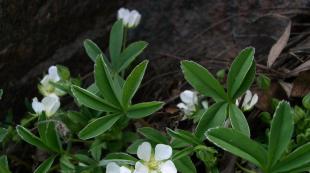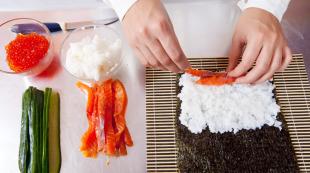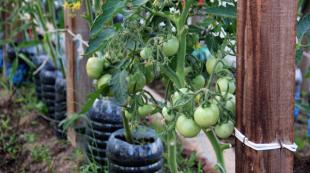Why the climbing rose does not bloom. Features of agricultural technology of climbing roses, everything from planting to shelter for the winter, plus personal experience
Of all the flowers, roses are considered the most revered in the world. They are symbols of countries, they are depicted on coats of arms and even give them magical properties. It is believed that roses grown in the yard help to find true love. A flower growing on the windowsill cleanses the house of negativity and brings harmony into it. AT landscape design Climbing roses have gained particular popularity. They make intricate compositions, use them to create hedges, decorate arches and pergolas. But it happens that a climbing rose does not bloom. The sooner gardeners understand the reason, the more chances to save the plants.
Reasons for the lack of flowering and their elimination
A climbing rose does not bloom in the first year. When growing on a personal plot, this must be taken into account. You should also take into account what kind of roses they are: climbers or ramblers. The latter in the first year will also not please with flowering, in addition, they are very demanding for care, especially preparation for cold weather.
Unsuitable soil

The soil for climbing roses should be nutritious and loose. Depleted soil cannot give anything to the plant, it will not bloom. Sandy and clayey areas are also not the best option for climbing roses. The first type of soil is too dry, and the second is heavy, dries slowly and does not allow oxygen to the roots.
Attention! Too heavy soils can be improved with sand, and sandy soil is balanced with clay. It is useful to add biohumus and humus to any soil.
Top dressing will help to enrich the composition of the soil. In the first year, fertilizers are not applied or only organic top dressing is used. Make infusions of chicken manure (concentration 1:20) or mullein (1:10). One bush goes from 3 to 5 liters of solution. In the spring, you need to make ammonia (30 g / m 2). The procedure is repeated every two weeks. When the buds begin to set, the plant needs nitrogen.
a lot of overgrowth

Nutrients stimulate the growth of new shoots and stems of climbing roses. However, in parallel, root shoots develop near the bushes. Excess branches should be cut off immediately. If this is not done, the bush will become untidy and shapeless, and the varietal climbing rose will gradually turn into a wild one. The plant will give all its strength to the formation of green mass, but it will not bloom.
Getting rid of root shoots is easy. It is necessary to cut them off with a sharp blade at the very surface of the earth. Small branches with thorns and leaves are also cut off. A neatly shaped climbing rose bush is more resistant to pests and blooms profusely.
Incorrect cropping

When forming a bush, you need to follow some rules, otherwise it will not bloom:
- Consider the variety of climbing roses. In some, flowers are tied on last year's shoots. In the summer they are pruned, as they will no longer produce buds. The shoot is pruned to the very base, from 3 to 10 new ones will grow in its place. Re-blooming varieties form differently. The main shoots are harvested in the fourth year, when they are completely weakened and turn into ugly hanging lashes.
- If the young shoots have grown too much and do not let light into the inside of the bush, they are removed.
- Last year's shoots are cut very carefully, capturing only the upper part, where there are no formed buds.
- Too thick stems with rough bark are best cut with a hacksaw.
- The cut is usually made over the outer kidney, holding the scissors at an angle. So it will not accumulate excess moisture. Immediately after pruning, the branches are treated with disinfectants.
- Anti-aging pruning is carried out in the spring, it is she who stimulates the appearance of buds. First of all, they get rid of the branches that grow inside the bush, as well as diseased and thin stems.
It is worth remembering that with too much pruning of a climbing rose, the bush begins to develop incorrectly.
Too little or too much fertilizer

If you overdo it with top dressing, climbing roses will also not bloom. Nitrogen-based fertilizers are especially insidious. Their excess leads to the rapid growth of shoots to the detriment of budding. Shoots become thick and densely overgrown with leaves, roses do not bloom. Top dressing with superphosphate, wood ash and potassium nitrate will help restore the balance of minerals in the soil. These fertilizers are much safer for climbing roses.
With a lack of minerals, problems arise not only with flowering. At the same time, the stems are deformed, suffers root system and the leaves change their normal color. To make the dressings harmonious, you can use complex fertilizers for climbing roses, strictly following the recommendations on the label.
Damage by pests and diseases

To the most dangerous diseases climbing roses include:
- Rust. This disease manifests itself in warm, humid weather, its causative agent is the fungus fragmidium. The danger is that spores fall on the plant from clothing, skin or garden tools. The stems and leaves of the climbing rose are covered with orange spots, it does not bloom, over time the green mass dries out and falls off. All leaves will have to be cut, the bushes should be sprayed with Bordeaux mixture and 3% iron sulfate, and the soil should be dug up.

- Powdery mildew. Another fungal infection It appears as a gray coating on the buds, branches and leaves. Plants are treated with various preparations: vitriol and potassium, colloidal sulfur, as well as folk remedy- soap and soda.

- Chlorosis. Appears from a lack of minerals in the soil. Leaves turn white or yellow. At this time, it is very important to feed the bushes with the necessary fertilizers.

- Spider mite. Insects live on the reverse side of the leaves and feed on their juice, while they wrap around them with a transparent cobweb. Effective way fight are tinctures based on tobacco, yarrow or wormwood.

- Rose leaflet. Insects lay eggs on leaf plates, from which white larvae appear. The leaves are curled up into tubes. You need to get rid of them. Plants are sprayed with Intavir, Karbofos or Iskra.

- Rose sawfly. The body of the insect is black, with a glossy sheen. The eggs are laid in the axils of the leaves, the larvae penetrate the stems and harm it, the climbing rose does not bloom. Fufanon and Intavir help in the fight against this pest.

Wrong landing site

In the first year of life, climbing rose bushes do not bloom. At this time, all the forces of the plant are spent on adapting to the soil, weather conditions, as well as on the formation of strong roots and healthy shoots. If the place is chosen incorrectly, roses will not be able to bloom.
Attention! Cuttings are planted in well-lit areas with moderate shading, where the soil warms up sufficiently. Full shadow is not suitable. In summer, under such conditions, the stems stretch ugly in search of light, and freeze out in winter.
Another condition is a slight slope of the site. So excess moisture can safely drain, without stagnation and without provoking the development of rot and fungi. Climbing roses do not like strong gusts of wind and drafts, in such conditions they do not bloom. Bushes are usually planted separately. Shrubs or trees growing nearby will rob climbing roses of the nutrients and moisture they need.
Wrong wintering

An important condition for the flowering of climbing roses is a reliable shelter for the winter. Severe frosts, interspersed with thaws, adversely affect the condition of the bushes and therefore they do not bloom. Plants are covered with synthetic material such as spunboard or lutrasil. To do this, you may additionally need pegs, arcs or frames.
It must be remembered that the plant must breathe. An easier way is to press the shoots to the ground and put a layer of spruce branches or spruce sawdust on them. Polyethylene is not recommended. It creates a greenhouse effect, from which the buds begin to bloom.
Aging

Climbing rose bushes age after about three years. The shoots become stiff, a dense layer of dark bark appears on them. Nutrients practically do not come from the roots to the stems, climbing roses do not bloom. The only way out is anti-aging pruning. After a while, young viable shoots will appear on the plants.
Conclusion
If the climbing rose does not bloom, do not be upset. You can solve this problem in a simple way, just adjusting the care for her. Climbing roses require increased attention and do not forgive mistakes. Only under ideal conditions will they delight gardeners with abundant and long flowering. Climbing roses will decorate large and small areas. They will turn an ordinary courtyard into a Garden of Eden, where harmony and beauty reign.
Roses decorate parks and gardens with exquisite flowers. And, when suddenly flowering does not occur, gardeners, especially inexperienced ones, begin to panic. The reasons why a rose does not bloom are numerous: age, lack of attention, improper pruning.
General rules for caring for roses
Roses open ground, as well as domestic ones, need a certain level of soil moisture, proper pruning, and winter rest.
Pre-winter pruning
Every year, so that roses can fully relax in the winter and gain strength, autumn pruning is carried out. After it in the spring, the shrub will be able to bloom much earlier. If the reason for the lack of color lies only in the absence of pruning, then by the summer it will be possible to admire the blooming buds.
The rose does not bloom
The most favorable time for pruning is when the night temperature approaches zero degrees and will stay at this mark for some time. If the procedure is carried out earlier, during a warmer period, then the bush can continue to grow, forming young shoots. Frosts will destroy them, and the flower will lose strength.
Important! Pruning is carried out over the cinquefoil, strong and developed, the kidney should be external.
The trimmed bush can withstand temperatures down to -10 ° C without additional shelter. For a quiet wintering, the plant is covered using a dry leaf, sawdust, spruce branches. Many flower growers cover the garden bush with plastic bags and dig in the bottom with earth to create a more comfortable wintering condition for the crop.
The indoor flower also needs rest. Continuous flowering can quickly deplete the plant.
When flowering is over, cut off the trunk. The old stem is removed at the root, the height of the stumps should not exceed 3 cm. A strong young shoot is cut off above the fifth bud.
Important! On the shoot of a room rose, there must be leaves.
After that, flower pots are taken out to a cool room.
Transfer
Can be grown in pots garden roses, however, the development of the root system in them is faster. In this regard, it is necessary to transplant annually, each time increasing the volume of the pot. However, no matter what size the flowerpot is, for 5-7 years the flower must be planted outside.
Rose transplant
For indoor varieties, you can not immediately use a large flowerpot. Until the roots fill the entire volume, the rose will not bloom. You can correct this error by transplanting into a smaller flowerpot.
Important! A spray rose transplant is carried out a month before the pre-winter pruning.
Watering and fertilizing
Garden flowers, and especially indoor flowers, need fertilizing and watering. If you stop watering garden flower, he will be able to get the necessary moisture from the soil and survive the forced drought, while a rose in a pot will completely dry out in a few days.
Immediately before autumn pruning, watering garden bushes is stopped. An excess of moisture in the soil will negatively affect the root system.
Watering resumes after the earth dries out from melt water. At the same time, nitrogen is introduced to make the plant bush more intensively.
Feeding roses
rose health
Any rose loves spraying with cool water. From this procedure, new buds form faster and their color is richer. After spraying, the room is ventilated. With stagnation and lack of air, indoor roses get sick.
A rose will signal a lack of moisture with yellowing and drying leaves. On hot summer days, when the buds begin to bloom intensively, the frequency of watering and spraying increases.
Important! Watering in the heat is carried out in the early morning and evening. If spraying is carried out during the day, the drops will act as a lens and can burn out the leaf.
Some varieties of roses cannot bloom because they have a bad neighbor in the flower bed. Lilac, spirea, mock orange prevent roses from blooming. They oppress the flower, actively taking away food. You should help the rose and transplant it to another place.
How many times a year do roses bloom
The nature of flowering subdivides plants into single and re-blooming. Many species form buds on last year's shoots. Wild roses bloom first, but their flowering is short and single.
wild roses
Garden roses bloom a little later, but among them there are varieties that have a repeated flowering period. The second time roses bloom weaker, their flowers are smaller.
Modern selection has provided a huge number of varieties of re-blooming roses that decorate the garden until frost. It is very rare to see when a rose blooms for the third time. This mainly happens in plants whose age exceeds 20 years. It would not be superfluous to mention that proper care was taken for such specimens.
Additional Information! Although it is generally accepted that roses live no more than 12 years, however, centenarians approaching the age of 40 are quite common among them.
It is possible to make a rose bloom for the third time, only for this it is necessary to create ideal conditions for it to grow and make a series of manipulations with equalizing pruning and reblooming. This is done in greenhouses where flowers are grown for sale.
Planting bushes of the first year may not bloom. It depends on the planting material and literacy of the florist. Moreover, the first flowering is not at all a necessity: the shrub should first be allowed to get stronger, then the flowering will be generous, however, next year.
Note! A climbing rose always throws out buds in the second year. In addition, in order to wait for flowering, the plant must be properly prepared for wintering.
Why do roses bloom poorly
If the rose bushes began to bloom poorly or stopped altogether, then something in the care was done wrong. Or maybe the pests tried.
Wrong landing site
Of decisive importance in the cultivation of roses is the place of their landing. Flowers love warmth and lots of light. They can develop normally if they are provided with full sun exposure for at least 8 hours a day. In shady places, the plant will not bloom.
Important! For planting roses, you need the most open area.
Necessary ecological conditions for a flower - lack of competition, permeable fertile soils, sunlight. The best way planting a flower - mono-flowers or rose gardens.
Incorrect cropping
Incorrect pruning is also the reason why the rose does not bloom. Some rose bushes cannot be severely pruned in the spring, only sanitization is practiced. This group includes climbings, English varieties, scrubs.
rose pruning
A long stalk shrub, shortened by half, will bloom too late, if at all deigns to throw out the buds. The rose will eliminate the lack of green mass at the expense of flowering.
To stimulate the appearance of flowering shoots, wilted flowers must be removed in a timely manner. It is advisable to carry out this procedure daily. At the same time, blind shoots should be identified and shortened by a strong bud. The rose begins to branch, throwing out new shoots on which there will be buds.
Spring pruning helps correct autumn mistakes. All missed unproductive shoots, very thin, damaged should be eliminated immediately. The shrub freed from them will concentrate on the creation and flowering of the main ones.
Wrong care
The culture requires intensive care: disease control, pest control, additional nutrition. An underfed, weakened shrub is more likely to drop leaves than bloom.
However, in feeding the plant, you need to observe the measure, so that later you will not be surprised why the rose does not bloom, but only leaves. So many media have recommendations for weekly feeding of roses. This cannot be done. Overfed plants grow intensively and increase green mass. And if they devote time to flowering, then it is extremely small: 1-2 buds may appear for the entire season.
Top dressing roses for abundant flowering
Feeding roses should be justified and balanced. Signs of lack of fertilizers:
- thin shoots;
- spots appear on the foliage;
- weak flowering.
Only then can you help the roses with food. With the onset of flowering, the culture will need potassium magnesia, potassium monophosphate. Florists with extensive experience often refuse chemical dressings in favor of organics: why process them if there is horse manure. Its effects on roses are simply magical - the flowers are bright, strong, flowering is long, and the rose itself does not get sick.
Aging, growth
Full flowering will not occur if the bush strangles the root growth. Rosehip, on which a rose is grafted, will give birth to a lot of shoots. It is easy for an inexperienced summer resident to make a mistake and take it for the stems of a grafted culture. Continuing to curl inside the bush, wild shoots drown it out, take away food, space, air, light. The dominance of the wild rose indicates a mistake made during planting: incorrect depth.
Important! The appearance of root shoots must be stopped immediately.
Very old rose bushes also stop intensive flowering - for the whole season only one bud may appear on the bush. Such plants rejuvenate.
It is difficult for old pink wood to feed foliage and, especially, flowers. Spring sanitary pruning helps to avoid this problem. Cutting out the woody stems, the owner helps the rose in the formation of new, young ones.
Important! The old branch is cut at ground level.
Ambulance
It happens that all the conditions for caring for a rose are met: young, has optimal nutrition, there is no root growth, the landing site is good, but still it does not bloom. The young florist is perplexed and lowers his hands.
Actions to be taken:
- Remove all, without exception, unnecessary shoots - thin, blind, small.
- Following is a stimulating circumcision on a strong bud, leaf.
- Offer the culture humate and potassium with trace elements.
Pests and diseases do not allow the plant to bloom. For each variety, the reason for this case is individual:
For a long time being engaged in flowers, each gardener accumulates his personal experience, records useful observations and methods applicable to certain colors. However, there are universal tips and observations that can be applied to many species:
- Feeding indoor roses while dormant will cause the stems to stretch too much.
- Picky home roses can be protected from pests by putting a few match heads when transplanting into a pot.
- When a rose is stunted, it is difficult to wait for flowering from it. Onion infusion will help correct this situation. It is a unique natural stimulant and antibiotic.
- Faded colors of foliage and flowers on rose bushes can be revived with a banana decoction. The crushed peel is poured with boiling water and kept for 2 days before feeding.
If rose bushes are given due attention, no pests and external causes will not prevent them from delighting everyone with their flowering.
Sometimes even experienced flower growers find it difficult to say why a rose does not bloom. Knowing the basic rules for caring for a beautiful flower will allow you to enjoy its magnificence of colors and delicious aroma.
When breeding roses, you need to be prepared for the fact that theoretical recommendations from specialists and the real situation in practice may have some discrepancies between them. Therefore, it is very difficult for even experienced flower growers to determine why a rose does not bloom. The reason for the lack of buds on the bush can be both insufficient air humidity, impurities in the soil, the composition of local water, and insufficient knowledge of the basics of caring for this beautiful flower. Let's analyze the main mistakes of flower growers. Read about
The rose does not bloom: the wildness of the bush
In most cases, growing roses in our area are grafted, not own-rooted. Therefore, you may not notice the appearance of wild shoots from the rootstock of a bush on which a cultivated rose is grafted. Such wild shoots weaken the bush, and it gradually loses its varietal properties. To prevent this from happening, it is necessary to remove this insidious growth, which is located at the very bottom, in a timely manner. It is easy to identify by very small leaves and a large number of thorns. As soon as you see such a whip, tear the earth and boldly cut it off at the very base.
Soil quality
Often a rose does not bloom due to unsuitable soil structure or improper processing. To prevent this from happening, you should not plant it in dense, heavy soil. To obtain a lighter composition, sand can be added under the bush and carefully loosened to a depth of 5-7 cm.
Fertilization
The reason why a rose does not bloom on the site may be a lack or excess of fertilizers applied to the soil. The main sign of an excess of nitrogen fertilizing is the active growth upwards of lush foliage without the formation of buds. You can correct the situation by applying phosphorus-potassium fertilizer or ash.
The menu of roses should include top dressing of low concentration from infusion of liquid organic matter or mineral fertilizers. Nutrient mixtures are applied alternately, alternating them every two weeks.
Pruning a rose bush
The purpose of pruning a bush is to rejuvenate it, which allows you to increase the abundance of flowering. The event is held every spring, thereby ridding the plant of weak, diseased and unproductive shoots, and the rest to receive impulses for further development.
First of all, when pruning, all weak, diseased branches damaged by frost and disease are removed. Next, cut off the shoots that are directed inside the bush.
This will ensure ventilation of the inside of the rose and eliminate the possible accumulation of pests and fungal diseases.
Next, all unproductive shoots are removed, which include branches older than 3 years. They are easily identified by their strongly lignified trunk and dark color. It is on such branches that in most cases buds do not appear, since their vessels have lost their elasticity and are completely clogged with salts. The remaining shoots are shortened in accordance with the rose variety. Pruning can be done up to 3-4 buds (short), 5-7 buds (moderate) and up to 8 buds (weak).
Wintering rose bush
 Also, the rose does not bloom as a result of improper wintering. To avoid freezing and exposure to moisture before the onset of cold weather, the rose bush should be covered with rotted peat, covered with protective material or fallen leaves. Also, experienced gardeners make special polystyrene foam cones and cover plants with them.
Also, the rose does not bloom as a result of improper wintering. To avoid freezing and exposure to moisture before the onset of cold weather, the rose bush should be covered with rotted peat, covered with protective material or fallen leaves. Also, experienced gardeners make special polystyrene foam cones and cover plants with them.
In addition to the above reasons, when choosing a variety, pay attention to its features. Since the reason why the rose does not bloom may be that the conditions of your site do not match for its full development.
Video: blind shoots of roses
Climbing roses ennoble household plots, facades of houses, fences. They braid arches, arbors, columns, garlands. The place where such a rose is planted immediately becomes the main focus on the site near the house or in the garden. Many cultivars have been bred in a variety of colors and shapes. The lack of flowers in a rose is a huge problem for a grower. To understand why buds do not appear, you need to understand the reasons for this phenomenon.
Landing place
In the first year of life, the rose does not bloom. A young plant takes root in a new place, gets used to the climate and soil. All forces are directed to the development of the root system and new shoots.A lot depends on the chosen location for the queen of the garden. A rose will not bloom if it grows in the shade. For the formation of flowers you need enough light and heat. Light day should be 8-10 hours. In a shady place, the stems develop incorrectly, they reach for the light, stretch out before they have time to ripen. In winter, shoots may freeze. Direct rays are also detrimental to the climbing bush. In the heat, there are few buds, the sun burns them, does not allow them to bloom.
So that the water does not stagnate, the selected area should have a slight slope. The length of the roots reaches 2 meters, so you can not plant in an area where ground water close to the earth's surface. If there is a risk of increased moisture, then a slight elevation is ideal for flowers.
Rosa does not like windy areas and drafts. In cold weather, the plant stops blooming and growing. A real queen doesn't want to share her space. Therefore, bushes should not be planted next to trees or shrubs. With a powerful rhizome, trees will be taken away useful material from the soil. The rose simply will not have enough nutrients for flowering. A beauty is planted at a distance of 70 cm from the nearest plant.
Attention!
It is not recommended to plant a plant close to the walls of the building; there is a risk of rapid depletion of the soil. The minimum distance from the building is 50-60 cm.
Weak ground

Rose prefers fertile, loamy, loose soil. The absence of flowers may indicate depletion of the soil. Clay and sandy soils are heavy for a rose bush.
To obtain a light substrate, sand is poured under the bush, the earth is carefully loosened. A little lime will help make the ground crumbly. To enrich the soil, top dressing is applied:
- feed in the spring ammonium nitrate, per square of earth 30 g of the substance, repeat after 15 days;
- organics - manure infusion 1:10, 4 liters of solution are spent per plant;
- during the period of bud development, the bushes are fertilized with nitrogen.
The soil before planting seedlings is loosened to a depth of 70 cm. The quality of the soil and tillage affect the formation of buds.
Too little or too much fertilizer

A large number of substances can harm the bushes, for example, nitrogen will give an impetus to the growth of foliage and shoots, but flowers will not appear. To increase soil fertility, humus, humus, phosphorus, and special bacteria are added. The way out of the situation with an excess of nitrogen is to add potassium salt, interfere with it with superphosphate.
Wood ash serves as a good top dressing for roses. It contains all the necessary substances, including potassium.
In the second year, rose bushes are fertilized several times during the year:
- the first time - at the beginning of summer, organic matter is introduced;
- the second top dressing is done 3 weeks after the first - with potash and phosphorus fertilizers;
- in July, you can add complex fertilizers for roses.
In the middle of summer, nitrogen-containing additives should not be used.
For the third year they feed:
- April - 100 g of complex mineral fertilizer per plant;
- fertilize the second time after the flowers wither - with mineral additives;
- in September you will need superphosphate 30 g per square meter.
Preparation of organic fertilizer: two weeks before application, manure is placed in a container, poured with water 1: 3. Potassium sulfate 30 g, superphosphate 20 g are added. The whole mass is mixed, infused for 10-12 days. Before watering, the solution is diluted with water 1:10, 3-4 liters are poured under the bush. In the autumn, when digging the row-spacing, 1 kg of compost is added to the square of the earth.
a lot of overgrowth

The growth of stems and new shoots requires nutrition. Next to the bush, a new root growth begins to develop. If you do not cut off all the extra branches in time, the plant will turn into a shapeless bush, it will start to run wild. Forces will be spent on the development of greenery, buds will stop appearing.
Cut the root processes near the ground with sharp garden shears. Small branches with thorns and leaves are removed. The formation of a neat bush will help to throw all the resources into flowering.
Pruning a bush in the spring rejuvenates the plant, allows you to increase the number of flowers. Weak, diseased, unproductive, as well as stems growing inside the bush are cut off. Thanks to pruning, the inside of the rose is ventilated.
Excessive pruning of the bush leads to improper development of the plant.
Diseases and pests

Excess moisture causes fungal diseases. Direct sunlight, lack of nutrition, cold, windy nights weaken the immunity of the rose. She begins to get sick, if signs of the disease are not noticed in a timely manner, the flower may die.
powdery mildew

At above 20 C*, during the growing season at high humidity the fungus Sferotica begins to develop. A gray coating forms on the leaves, which appears on the buds and branches. Tissues are destroyed, parts of the plant die.
As a preventive measure, the rose garden is planted in sunny, ventilated areas. Digging the soil also gives good results. The affected parts are cut off and destroyed.
Used drugs:
- in March, they are sprayed with vitriol with potassium (sulfate) 0.3%;
- spraying is carried out with colloidal sulfur 1%;
- spray a solution of soda and soap on the bush, 50 g per bucket of water;
- until the roses bloom, during the growing season use copper and soap: 300 ml liquid soap for 10 liters of liquid, 30 g blue vitriol pour into 1 liter of water, combine, mix.
In summer, spray 3 times every 8-10 days. Processing is carried out in October before preparing for winter.

On the bark appear brown spots, which turn black, forming rings around the stem. Such branches must be pruned. In order for the plant to be able to resist cancer, they feed it with potassium, stop feeding it with nitrogen. In September, potassium sulfate 20 g, superphosphate 30 g are added. Timely shelter for the winter, cutting off diseased shoots, and airing the bushes during the thaw period are necessary.
Rust

After the rains, when it is warm, the phragmidium fungus moves through the water and falls on neighboring bushes. It can be carried by gardeners on overalls, hands, tools. Orange spots are formed on stems, peduncles, leaves. The foliage dries up and falls, the flowers are deformed.
In the fight against rust, all foliage is removed, scorched. They dig up the ground, the bushes are treated with Bordeaux liquid, iron sulfate 3%. In the spring they are treated with Hom, Falcon.
Peronosporosis

In hot, humid times, the disease develops. Brown spots appear on the leaf blades. To avoid this, roses are fertilized with phosphorus and potassium. Fungicides are used: Zircon, Strobi, Privekurom. In case of severe damage, the entire bush is removed to avoid mass infection.
Chlorosis

If there are not enough trace elements in the soil, the foliage turns yellow or white, subsequently it falls off. It is necessary to establish which element the flower lacks and feed it. Soil samples can be taken and analyzed.
thrips

Barely noticeable insects are yellow or brown. The female lays life cycle 300 eggs. Consequences - the buds do not open, the leaves are deformed. For the destruction of insects, one of the means is bred: Fufanon 10 ml, Karbofos 60 g, Intavir 1 tablet per bucket of water.
spider mite

An effective remedy against ticks is a tincture of tobacco, wormwood, shag, yarrow. Wormwood helps fight caterpillars, aphids, mites, rust. For prevention, all rose bushes are sprayed with it.

Black insect with a brilliant shade up to 10 mm in length. The eggs are in the axils of the leaves. The larvae move inside the stem, damaging it. The plant dries up. To combat them, the same means are used as with thrips.
rose leaflet

Insects lay their eggs on leaf plates, they curl up. White larvae appear inside. In July, they grow up to 1 cm. Twisted leaves are plucked and destroyed. Substances used: Spark, Intavir, Karbofos.
They love the rose and other harmful insects: green rose aphid, rose cicada, caterpillars. A decoction of horsetail strengthens the immunity of climbing roses, has a detrimental effect on mites, fights rust, powdery mildew. For infusion, take 1 kg of grass, pour cold water 1:10, insist for a day, cook for half an hour, filter. Spray bushes on hot days.
Wintering climbing rose

Incorrect preparation of plants for winter can adversely affect flowering next year. Roses need shelter in winter time. Low temperatures can kill tender bushes. Spring thaw, dampness, rains cause fungal diseases. Solution - synthetic material for shelter: spanboard, agrotek, lutrasil. Use frames, arcs, stakes. You can use spruce branches, spruce sawdust. To do this, the shoots are bent to the ground and laid on a layer of spruce branches. Plants are dug up on one side and placed so that they do not break.
Do not cover roses with plastic wrap. The greenhouse effect can cause bud break during the winter.
Bushes are covered at a temperature of 5-7 degrees, not lower. This is mainly done in November in dry weather. Starting from September, watering is reduced, potash fertilizers are added, the tops are cut off. Remove the supports, lay on the fallen leaves and cover.

- the difference between a climbing rose and other varieties is that it blooms on last year's shoots, so they must cover the growth for the winter;
- in the second year, many side shoots grow, if they are not removed, then in the third year of life, the rose will give few flowers;
- the remaining shoots are cut by a third, this procedure awakens the lower buds;
- slices are best lubricated with brilliant green or iodine;
- the formation of the bush is done only after flowering;
- the rose loves horse manure, flowering will be plentiful;
- if you need to plant bushes against the wall, then this should be the south side;
- in autumn, when pruning, leave about 5 strong annual shoots;
- it is impossible to allow the rose to creep along the ground, if it does not braid the arch, the arbor, then it is necessary to make supports for it;
- while working in the garden, when pruning branches, use a sterile tool;
- shoots or buds must not be broken off, only cut with sharp scissors or secateurs;
- a plant transplant is done as a last resort, if an unsuccessful place is chosen and the rose does not bloom, it is transplanted in the spring, before the buds awaken, or in September.
In the spring, when the temperature rises to 10 degrees, the shelter is removed. Without fresh air fungi can develop, the plant will get sick. Airing on winter days, when the thaw sets in, is a mandatory procedure for climbing roses.
I don’t know myself, I found it on the internet, maybe you can figure out your reason:
1. Improperly selected or cultivated soil
Roses love fertile, loose soil, so soil that is too dense and heavy is unlikely to work. If, nevertheless, the choice is small, and a place with depleted soil is chosen, then it is worthwhile to approach the issue of feeding more carefully. An obligatory stage in preparing the hole for planting is loosening the soil to a depth of 50-70 cm, it is to this depth that the roots of the rose grow.
2. The wrong place
Roses love open spaces, well lit by the sun and protected from the wind. In the shade and in a draft, these fragile flowers will not only not bloom, but will generally develop very slowly.
3. Insufficient watering
Roses are drought tolerant, but plants will devote all their energy to maintaining viability, and not to flowering. Therefore, in the hot time of the day, the soil around the bushes should be regularly moistened.
4. Poorly endured wintering
A rose bush can stop the development and formation of buds if it has not wintered well, it has frozen. Therefore, you need to approach this issue very responsibly, starting preparations even before the season of prolonged rains, otherwise the bush will pick up moisture.
5. Incorrect cropping
This is a whole science, and for different groups and varieties of roses there are certain rules. For example, if roses bloom a second time, you need to remove the upper part of the shoot with a dried flower, cutting it obliquely and leaving 5-8 mm above the next eye. Caution should be done on climbing roses of the Rambler group, which bloom only on last year's shoots, removing only the frozen ends of the lashes - then you will not have to wonder why the rose does not bloom.
Periodically, old bushes need to be rejuvenated, also pruning according to the rules, removing thin and weak branches, as well as old stiff lashes, leaving 3-5 strong lashes.
6. "Wild" rose bush
Since most of the roses in our area are grafted, and not rooted, you can skip and not remove the wild shoots from the rootstock, the bush on which the cultivated rose sprout is grafted, in time. These wild whips gradually weaken the plant, and the rose can easily lose its varietal qualities. It is very easy to recognize the insidious growth: it grows from below, the leaves are smaller, a large number of thorns. As soon as you see something like this, tear up the ground and cut off the branch at the very base.7.
7. Incorrect feeding or overfeeding
Sometimes a rose bush instead of flowers begins to violently form lush foliage and actively grow up. This, in most cases, is a consequence of an excess of nitrogen fertilizers. This is corrected by the introduction of phosphorus-potassium fertilizers or simply ash, but the effect will not be immediately noticeable.
We hope that the analyzed situations will help you avoid mistakes and now you already know exactly why the rose does not bloom.









